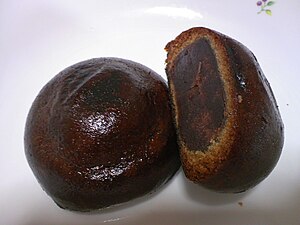Manjū
This article has multiple issues. Please help improve it or discuss these issues on the talk page. (Learn how and when to remove these messages)
|
 | |
| Type | Wagashi |
|---|---|
| Course | Dessert, snack |
| Place of origin | Japan |
| Region or state | East Asia |
| Main ingredients | Flour, buckwheat, red bean paste |
Manjū (饅頭, まんじゅう) is a traditional Japanese confection, usually a small, dense bun with a sweet filling. They come in many shapes and varieties.
The standard manjū has a skin made of flour, and is filled with anko (sweet azuki bean paste). Some varieties use kudzu starch or buckwheat flour for the skin. Other types of filling include sweet potato, chestnut jam, or custard.
Manjū is usually steamed or baked, though fried manjū can be found in some modern restaurants. Traditional manjū are usually round, but many different shapes exist today, and some are proprietary to specific bakeries.
History
[edit]
Manju is a traditional Japanese flour-based pastry (instead of rice-based like mochi). During the Kamakura period (1185–1333), Japanese Buddhist monks who studied in the Song dynasty brought the tea culture to Japan, and the custom of eating confections with tea began in Japan.
The monks also introduced tenshin (点心, dim sum), a light meal, and the history book Teikun ōrai (庭訓往来) mentions udon (饂飩), manjū (饅頭), and yōkan (羊羹) as tenshin (点心).
It is believed that the monk Enni introduced manjū production techniques in Hakata, Fukuoka Prefecture in 1241. Upon returning from China, he built Joten-ji, a temple of the Rinzai sect in Hakata. He then gave a manjū recipe to a teahouse owner who was always kind to him when he went on takuhatsu (begging rounds) around Mount Aratsu, to the west of Hakata. At that time, he gave the teahouse owner a hand-written signboard with the words "Omanjū Dokoro" ("Place to Eat Manjū"), which is now in possession of Toraya Kurokawa in Akasaka, Tokyo. There is also a stone monument in the garden of Joten-ji temple that commemorates the introduction of manjū to Japan.[1]

However, the manjū and yōkan brought to Japan by the monks were not sweets as we know them today, but were prepared in a completely different way.[2] At that time, manjū resembled Chinese mantou, which is written with the same kanji. It was not a confection, did not contain red bean paste, and was not sweet. The history book Sōgo ōzōshi (宗五大草紙) clearly describes manjū as a dish eaten with chopsticks along with soup and pickles. Later, manjū changed from a light meal to a confection to suit Japanese tastes. In the Muromachi period (1336–1573), Shokunin utaai ehon (職人歌合画本) depicted sweet manjū made with sugar. This manjū is considered the prototype of today's manjū.[2]
Varieties
[edit]

Of the myriad varieties of manjū, some more common than others. In Hawaii, one can find Okinawan manjū that are made with a filling of purple sweet potato, butter, milk, sugar, and salt, but the most common filling is bean paste, of which the several varieties include koshian, tsubuan, and tsubushian.
- Matcha (green tea) manjū is one of the most common. In this case, the outside of the manjū has a green tea flavor and is colored green.
- Mizu (water) manjū is traditionally eaten in the summertime and contains a flavored bean filling. The exterior of the mizu manjū is made with kuzu starch, which gives the dough a translucent, jelly-like appearance.[3]
- Horaku manjū is sweet dough filled with either red bean paste made from adzuki beans or white bean paste made from white kidney beans and is one of the most popular kinds of manju in Kyushu, especially in Fukuoka, Kumamoto, Kagoshima and Miyazaki prefectures. This, or very similar, type of manjū is also being sold at a street stall in Jotenji-dori in Fukuoka, just meters away from the manjū monument on the grounds of Joten-ji Temple, that commemorates manjū being brought from China by monk Enni.
- Also, manjū can have different flavored fillings, such as orange-flavored cream.
- As is the case with many Japanese foods, in some parts of Japan, one can find manjū unique to that region, such as the maple leaf-shaped momiji manjū in Hiroshima and Miyajima.
- The regional variety of the Saitama prefecture is called Jumangoku manjū.
Gallery
[edit]See also
[edit]- Daifuku
- List of Japanese desserts and sweets
- Mamador
- Mantou (饅頭, Chinese plain steamed bun), etymologically the origin of the word, although in modern Chinese the term for filled buns is baozi
- Manti (Turkic) and mandu (Korean), filled dumplings with the names being cognate with mantou and manjū
- Momiji Manju
- Nikuman
- Tangyuan
- Kozhukkatta is a steamed dumpling made from rice flour, with a filling of grated coconut, jaggery, or chakkavaratti in South India.
References
[edit]- ^ "Manju (Bun stuffed with filling) (饅頭)". www.japanesewiki.com. Retrieved 16 June 2024.
- ^ a b 駆け足でたどる和菓子の歴史 (in Japanese). National Diet Library. Archived from the original on 22 February 2024. Retrieved 22 February 2024.
- ^ Schilling, Christine (2007). "Translator's Notes." in Kirishima, Takeru (2002). Kanna Volume 2. California: Go! Comi (Go! Media Entertainment, LLC). ISBN 978-1-933617-56-5
External links
[edit] Media related to Manjū at Wikimedia Commons
Media related to Manjū at Wikimedia Commons- Kashiwaya (Japanese)
- Kashiwaya Usukawa Manju(Instagram)






